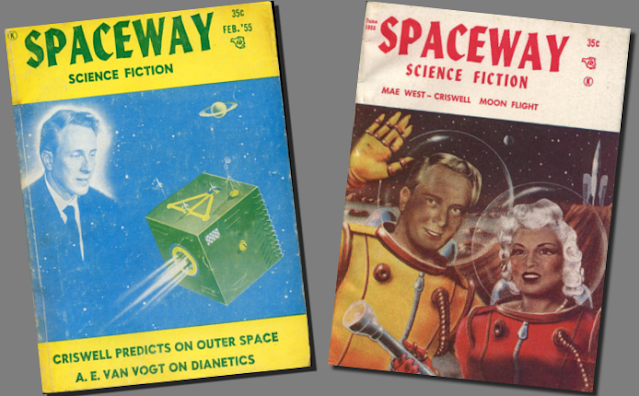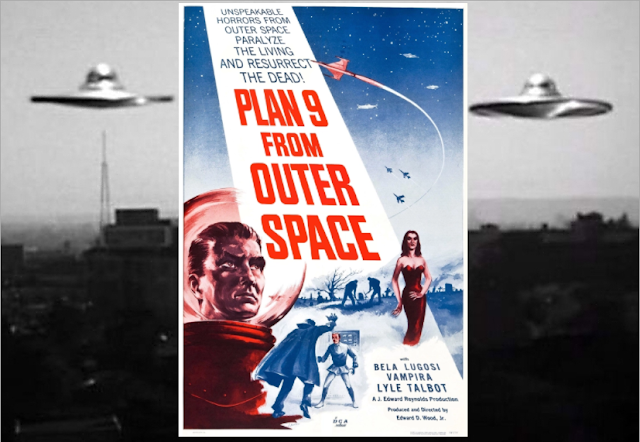The Amazing Criswell's UFO involvement goes much deeper than just hosting the flying saucer invasion movie, Plan 9 from Outer Space.
Criswell aka Jeron King Criswell (originally Jeron Criswell Konig) was an astrologer and psychic to Hollywood stars. He became a minor celebrity himself, with his own television show, newspaper column, and was a frequent guest on talk shows.
Fate magazine brought us news of flying
saucers and the paranormal and early issues also featured the column, Criswell
Predicts.
Criswell's column from Oct. 2, 1950 included a UFO book review:
"On your book shelf, there is one book that is building to a best seller by word of mouth, and that is Richard S. Shaver's exciting 'I Remember Lemuria,' which gives evident proof that the ancient races still live, the Atlans, the Titans and many others who return to this earth in 'flying saucers' after 200 centuries of living beyond the blue. This startling information is backed by some of our most prosaic scientists of 1950!"
"The next trend in fiction will be the brutal interplanetary invasions and wars, which Fate Magazine has pioneered for some time." Another hit was at the end of 1952. Criswell had many predictions for the coming year and said that the US would “undergo an epidemic of flying saucers.”
Criswell and the World's First Flying Saucer Convention
In the early 1950s, Criswell was a
member of a flying saucer club in Los Angeles., and in 1953 they put together a convention. Orfeo Angelucci described its origins
in his 1955 book, The Secret of the Saucers.
“… as the crowds increased, the Club House was no longer large enough to accommodate everyone. It was then that Max Miller... and [Jeron] Criswell, the well-known columnist and television Man of Prophecy, suggested that we rent the music room in the famous old Hollywood Hotel for our weekly meetings. …[Later] Miller conceived the idea of a Flying Saucer Convention.”
It was billed as “the World's First Flying Saucer Convention,”
and held at the Hollywood Hotel on August 16-18, 1953. Although some scientific
and serious UFO researchers were invited, they declined and most of the speakers
were more in the Contactee camp. Criswell served as the convention’s principal
program moderator and guests included Frank
Scully, Silas Newton, Forrest J. Ackerman,
George Adamski, Truman Bethurum, Orfeo Angelucci, George Van Tassel, and
Max Miller. By some accounts, over 1500 people attended and the facilities were
filled beyond capacity.
 |
| SAUCERS, Dec. 1953 |
Based on its success, the next year George Van Tassel launched an annual Spacecraft Convention at Giant Rock, California. Ever since, UFO conferences have been a little corner of show business.
Criswell on Captured Flying
Saucers and Disclosure
Criswell was associated with the UFO topic strongly enough for that he was described as a “TV prophet and saucer columnist,” in Gray Barker’s The Saucerian magazine. Barker's Saucerian Bulletin: shared a Criswell prediction of imminent UFO Disclosure:
"On the ABC-TV show, 'You Asked for It,' of several weeks ago, Criswell, the widely syndicated West Coast columnist who makes his living by trying to peer into the future, predicted flatly that an announcement on just what flying saucers are would be made by the government on Dec 10, 1953."
The Roundhouse, October 1953 (newsletter for Maquoketa, Iowa Cup & Saucer Club) reported further details: "Criswell has predicted that the government will make an official announcement on the existence of flying saucers on December 10, 1953. He previously said we would have space travel by 1963 because of the captured flying discs.”
There was at least one skeptical piece by Criswell from a 1954 column. The wife of an alleged Contactee wrote in and Criswell said his nonsense shouldn't be encouraged.
The newspaper column Criswell Predicts continued to occasionally mention flying saucers among his other prophecies, and in late 1955, Criswell had a particularly emphatic one:
“I predict that Capt. Eddie Rickenbacker will make a most startling statement of factual evidence concerning flying saucers before March 30, 1956! Remember this prediction!”
In 1956, Criswell was the narrator for Ed Wood’s flying saucer movie, Plan 9 from Outer Space, which was later released in 1958. Criswell opens this possibly prophetic tale by saying, “We are all interested in the future, for that is where you and I are going to spend the rest of our lives.”
“Can you prove it didn’t happen?… God help us in the future!”
The 1968 book, Criswell Predicts Your Future from Now to the Year 2000, contained a few mentions of the mysteries of space and UFOs:
“In the vision of many men, we have seen the inhabitants of other planets who have visited our earth. I predict that these visits will increase in frequency over the next 20 years. By 1988, there will be substantiated records of visits to earth from other planets.
And, from time to time, many earth people will leave this earth to return to alien planets with the visitors from outer space. And, in the long run, these will be the lucky ones. For they and their descendants will escape the doomsday that will come on August 18, 1999.”
His 1970 record, The Legendary Criswell Predicts! Your Incredible Future, contained another bold saucer prophecy:
"I predict that flying saucers will officially land on the lawn of the White House to open up a new outer-space, inter-world treaty. Mark this date on your calendar: May the sixth, 1991."
In his Criswell Predicts column for July 24, 1977:
“UFOs Again – I predict that in coming court trial for damages, our government will be forced to admit that unidentified flying objects do exist and damages will be paid for personal injuries to person and property. This will be one of the top cases of the year.”
In October 1977 Criswell spoke at George Van Tassel’s Spacecraft Convention at Giant Rock, California. He said of the location, “The area becomes alive at dusk, when you can actually hear… a funny whirring sound of the space people around Giant Rock.”
Criswell did not live to see Earth’s doomsday he predicted at the end of the century. He died on October 4, 1982.
See the article, “Who was Criswell?” at the Criswell Predicts site for more on his biography beyond his saucer exploits.




























